2021 HONDA CLARITY FUEL CELL power steering
[x] Cancel search: power steeringPage 8 of 555

6
Quick Reference Guide
Quick Reference Guide
Visual Index
❚Steering Wheel Adjustments (P 171)
❚ (Vehicle Stability AssistTM (VSA®)
System OFF) Button
(P 416)
❚Road Departure Mitigation (RDM)
Button
(P 388)❚Gauges (P 118)
❚Collision Mitigation Braking SystemTM
(CMBSTM) OFF Button (P 438)
❚Head-Up Display Buttons (P 129)
❚Driver Information Interface
(P 121)
❚Navigation System
() See the Navigation System Manual
❚Audio System (P 200)
❚Hazard Warning Button
❚Climate Control System (P 190)
❚POWER Button (P 156)
❚Seat Heater Buttons (P 188)
❚Rear Defogger (P 168)
❚Heated Door Mirror Button (P 168)
❚System Indicators (P 88)
21 CLARITY FCV CSS-31TRT6400_02.book 6 ページ 2020年9月25日 金曜日 午後3時15分
Page 28 of 555

26
Quick Reference Guide
Instrument Panel (P 87)
Lights On Indicator
System Indicators
12-Volt Battery
Charging System
IndicatorAnti-lock Brake
System (
ABS)
Indicator
Vehicle Stability
Assist
TM (VSA
®) System
Indicator
VSA ® OFF Indicator Electric Power
Steering (EPS)
System Indicator
Lights Indicators
High Beam Indicator
Seat Belt Reminder
Indicator
System Indicators
System Message
Indicator
Parking Brake and
Brake System
Indicator (Red) Supplemental
Restraint System
Indicator
Gauges (P 118)/Driver Information Interface (P 121)/
Head-Up Display
(P 129)/System Indicators (P 88)
Low Tire Pressure/
TPMS Indicator Turn Signal and
Hazard Warning
Indicators
Speedometer
Automatic Brake Hold
System Indicator Parking Brake and
Brake System
Indicator (Amber)
SPORT
Mode Indicator
Collision Mitigation
Brake System
TM
(CMBSTM) Indicator
Road Departure
Mitigation (RDM)
Indicator
Immobilizer System Indicator/
Security System Alarm Indicator
Automatic Brake Hold
Indicator
Head-Up Display
READY Indicator
POWER SYSTEM
Indicator
Gear Position
Indicator
Fuel Gauge
Driver Information
Interface
High Voltage Battery
Charge Level Gauge
POWER/CHARGE
Gauge
Low Fuel Indicator
Hydrogen Leak
Indicator Adaptive Cruise
Control ( ACC) with
Low Speed Follow
Indicator
Lane Keeping Assist
System ( LKAS)
Indicator
21 CLARITY FCV CSS-31TRT6400_02.book 26 ページ 2020年9月25日 金曜日 午後3時15分
Page 58 of 555
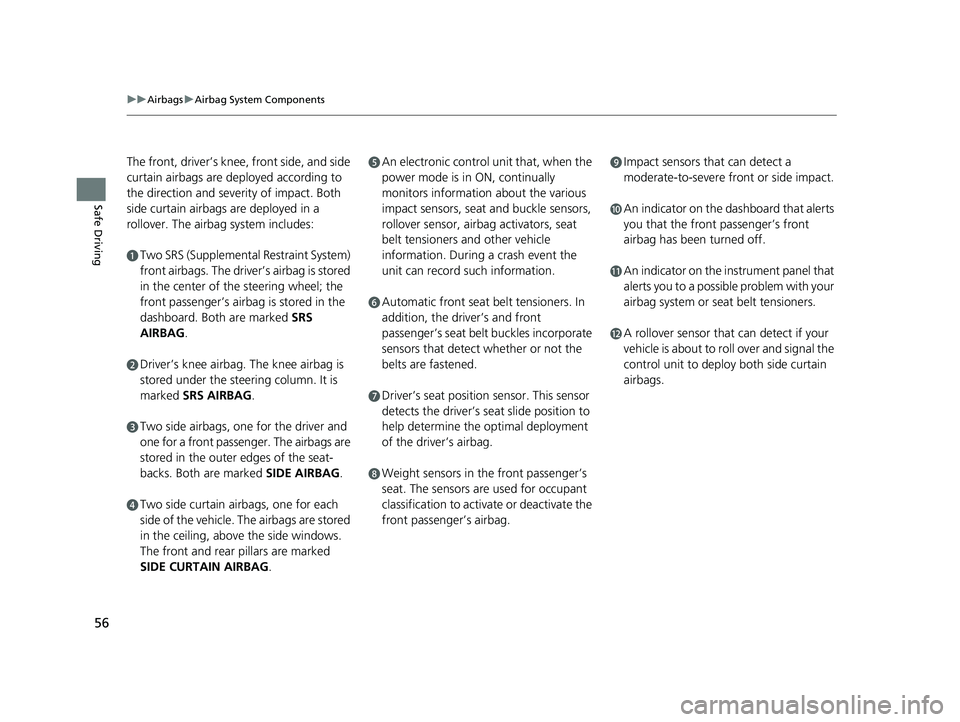
56
uuAirbags uAirbag System Components
Safe Driving
The front, driver’s knee, front side, and side
curtain airbags are deployed according to
the direction and severity of impact. Both
side curtain airbags are deployed in a
rollover. The airbag system includes:
aTwo SRS (Supplemental Restraint System)
front airbags. The driver’s airbag is stored
in the center of the steering wheel; the
front passenger’s airbag is stored in the
dashboard. Both are marked SRS
AIRBAG.
bDriver’s knee airbag. The knee airbag is
stored under the steering column. It is
marked SRS AIRBAG.
cTwo side airbags, one for the driver and
one for a front passenger. The airbags are
stored in the outer edges of the seat-
backs. Both are marked SIDE AIRBAG .
dTwo side curtain airbags, one for each
side of the vehicle. The airbags are stored
in the ceiling, above the side windows.
The front and rear pillars are marked
SIDE CURTAIN AIRBAG.
eAn electronic control unit that, when the
power mode is in ON, continually
monitors information about the various
impact sensors, seat and buckle sensors,
rollover sensor, airbag activators, seat
belt tensioners and other vehicle
information. During a crash event the
unit can record such information.
fAutomatic front seat belt tensioners. In
addition, the driver’s and front
passenger’s seat belt buckles incorporate
sensors that detect whether or not the
belts are fastened.
gDriver’s seat position sensor. This sensor
detects the driver’s seat slide position to
help determine the optimal deployment
of the driver’s airbag.
hWeight sensors in the front passenger’s
seat. The sensors are used for occupant
classification to activate or deactivate the
front passenger’s airbag.
iImpact sensors that can detect a
moderate-to-severe front or side impact.
jAn indicator on the dashboard that alerts
you that the front passenger’s front
airbag has been turned off.
kAn indicator on the instrument panel that
alerts you to a possib le problem with your
airbag system or seat belt tensioners.
lA rollover sensor that can detect if your
vehicle is about to roll over and signal the
control unit to deploy both side curtain
airbags.
21 CLARITY FCV CSS-31TRT6400_02.book 56 ページ 2020年9月25日 金曜日 午後3時15分
Page 60 of 555
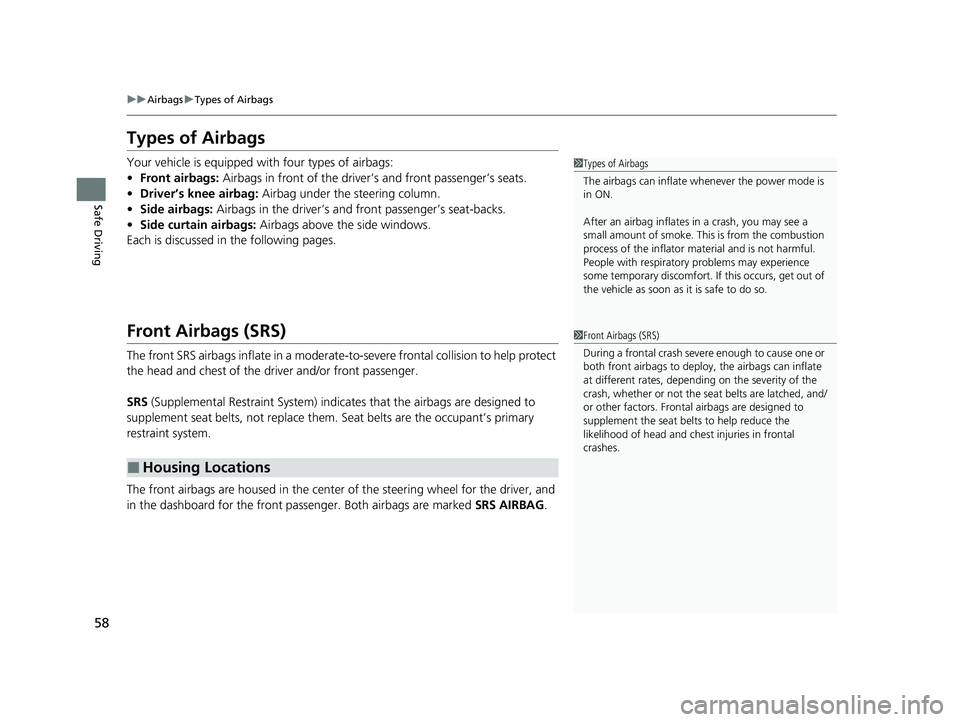
58
uuAirbags uTypes of Airbags
Safe Driving
Types of Airbags
Your vehicle is equipped with four types of airbags:
• Front airbags: Airbags in front of the driver ’s and front passenger’s seats.
• Driver’s knee airbag: Airbag under the steering column.
• Side airbags: Airbags in the driver’s and front passenger’s seat-backs.
• Side curtain airbags: Airbags above the side windows.
Each is discussed in the following pages.
Front Airbags (SRS)
The front SRS airbags inflate in a moderate-to -severe frontal collision to help protect
the head and chest of the driver and/or front passenger.
SRS (Supplemental Restraint System) indicates that the airbags are designed to
supplement seat belts, not replace them. Seat belts are the occupant’s primary
restraint system.
The front airbags are housed in the center of the steering wheel for the driver, and
in the dashboard for the front pass enger. Both airbags are marked SRS AIRBAG.
■Housing Locations
1Types of Airbags
The airbags can inflate whenever the power mode is
in ON.
After an airbag inflates in a crash, you may see a
small amount of smoke. This is from the combustion
process of the infl ator material and is not harmful.
People with respiratory pr oblems may experience
some temporary discomfort. If this occurs, get out of
the vehicle as soon as it is safe to do so.
1 Front Airbags (SRS)
During a frontal crash severe enough to cause one or
both front airbags to deploy, the airbags can inflate
at different rates, dependi ng on the severity of the
crash, whether or not the se at belts are latched, and/
or other factors. Frontal airbags are designed to
supplement the seat belts to help reduce the
likelihood of head and chest injuries in frontal
crashes.
21 CLARITY FCV CSS-31TRT6400_02.book 58 ページ 2020年9月25日 金曜日 午後3時15分
Page 97 of 555

95
uuIndicators u
Continued
Instrument Panel
IndicatorNameOn/BlinkingExplanationMessage
Supplemental
Restraint System
Indicator
●Comes on for a few seconds when
you set the power mode to ON,
then goes off.
●Comes on if a problem with any of
the following is detected:
-Supplemental restraint system
- Side airbag system
- Side curtain airbag system
- Seat belt tensioner
●Stays on constantly or does not come
on at all - Have your vehicle checked by
an authorized Honda Clarity Fuel Cell
dealer.
Electric Power
Steering (EPS)
System Indicator
●Comes on when you set the power
mode to ON, and goes off when
the power system is on.
●Comes on if there is a problem
with the EPS system.
●Stays on constantly or does not come
on at all - Have your vehicle checked by
an authorized Honda Clarity Fuel Cell
dealer.
2 If the Electric Power Steering (EPS)
System Indicator Comes On P. 516
Vehicle Stability
AssistTM (VSA®)
System Indicator
●Comes on for a few seconds when
you set the power mode to ON,
then goes off.
●Blinks when VSA ® is active.●Comes on if there is a problem
with the VSA® system.
●Stays on constantly - Have your vehicle
checked by an author ized Honda Clarity
Fuel Cell dealer.
2 Vehicle Stability AssistTM (VSA ®), aka
Electronic Stability Control (ESC),
System P. 415
Vehicle Stability
AssistTM (VSA®)
OFF Indicator
●Comes on for a few seconds when
you set the power mode to ON,
then goes off.
●Comes on when you partially
disable VSA®.
2 VSA ® On and Off P. 416
21 CLARITY FCV CSS-31TRT6400_02.book 95 ページ 2020年9月25日 金曜日 午後3時15分
Page 135 of 555
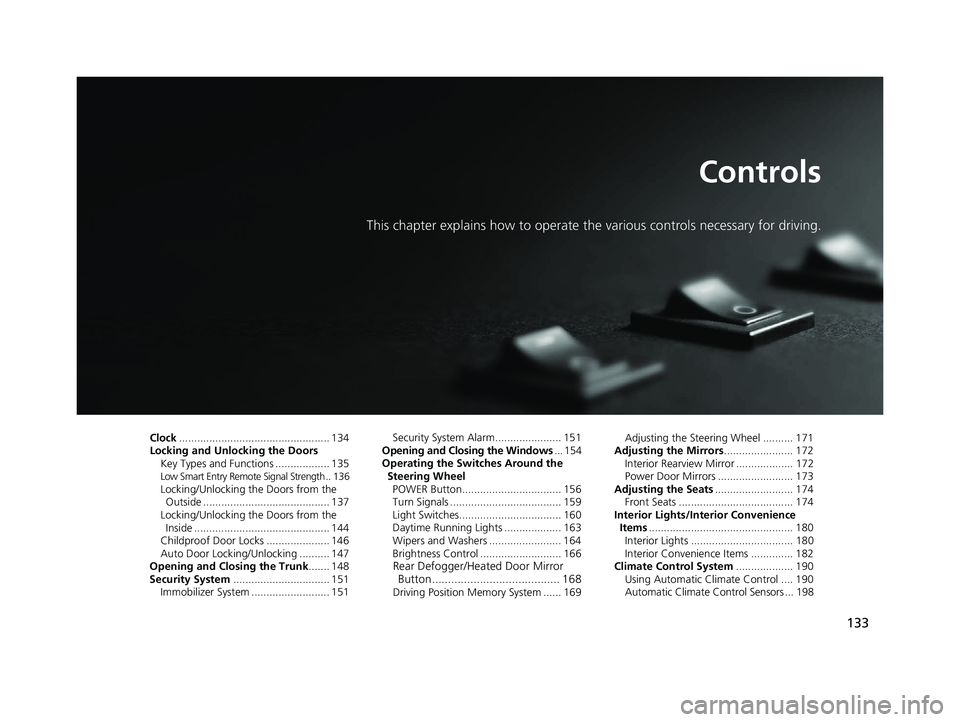
133
Controls
This chapter explains how to operate the various controls necessary for driving.
Clock.................................................. 134
Locking and Unlocking the Doors Key Types and Functions .................. 135
Low Smart Entry Remote Signal Strength .. 136Locking/Unlocking the Doors from the Outside .......................................... 137
Locking/Unlocking the Doors from the Inside ............................................. 144
Childproof Door Locks ..................... 146
Auto Door Locking/Unlocking .......... 147
Opening and Closing the Trunk ....... 148
Security System ................................ 151
Immobilizer System .......................... 151 Security System Alarm...................... 151
Opening and Closing the Windows ... 154
Operating the Switches Around the
Steering Wheel POWER Button................................. 156
Turn Signals ..................................... 159
Light Switches.................................. 160
Daytime Running Lights ................... 163
Wipers and Washers ........................ 164
Brightness Control ........................... 166
Rear Defogger/Heated Door Mirror Button........................................ 168
Driving Position Memory System ...... 169 Adjusting the Steering Wheel .......... 171
Adjusting the Mirrors ....................... 172
Interior Rearview Mirror ................... 172
Power Door Mirrors ......................... 173
Adjusting the Seats .......................... 174
Front Seats ...................................... 174
Interior Lights/Interior Convenience Items ................................................ 180
Interior Lights .................................. 180
Interior Convenience Items .............. 182
Climate Control System ................... 190
Using Automatic Climate Control .... 190
Automatic Climate Control Sensors ... 198
21 CLARITY FCV CSS-31TRT6400_02.book 133 ページ 2020年9月25日 金曜日 午 後3時15分
Page 158 of 555
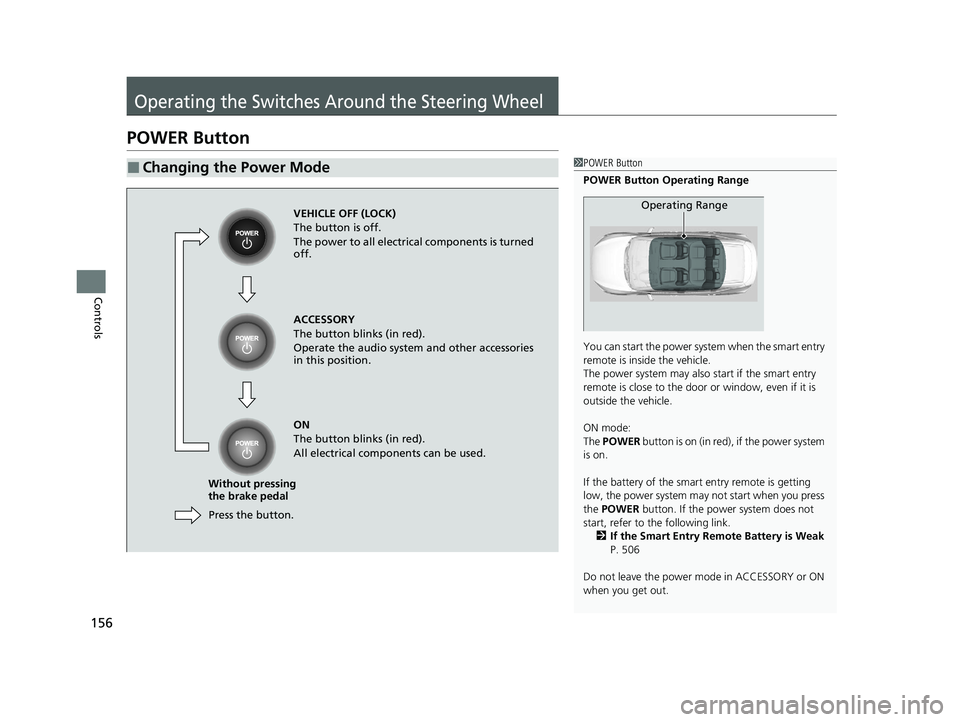
156
Controls
Operating the Switches Around the Steering Wheel
POWER Button
■Changing the Power Mode1POWER Button
POWER Button Operating Range
You can start the power system when the smart entry
remote is inside the vehicle.
The power system may also start if the smart entry
remote is close to the door or window, even if it is
outside the vehicle.
ON mode:
The POWER button is on (in red), if the power system
is on.
If the battery of the smar t entry remote is getting
low, the power system may not start when you press
the POWER button. If the power system does not
start, refer to the following link.
2 If the Smart Entry Remote Battery is Weak
P. 506
Do not leave the power mode in ACCESSORY or ON
when you get out.
Operating RangeVEHICLE OFF (LOCK)
The button is off.
The power to all electrical components is turned
off.
Press the button.
Without pressing
the brake pedal ACCESSORY
The button blinks (in red).
Operate the audio system and other accessories
in this position.
ON
The button blinks (in red).
All electrical components can be used.
21 CLARITY FCV CSS-31TRT6400_02.book 156 ページ 2020年9月25日 金曜日 午
後3時15分
Page 159 of 555
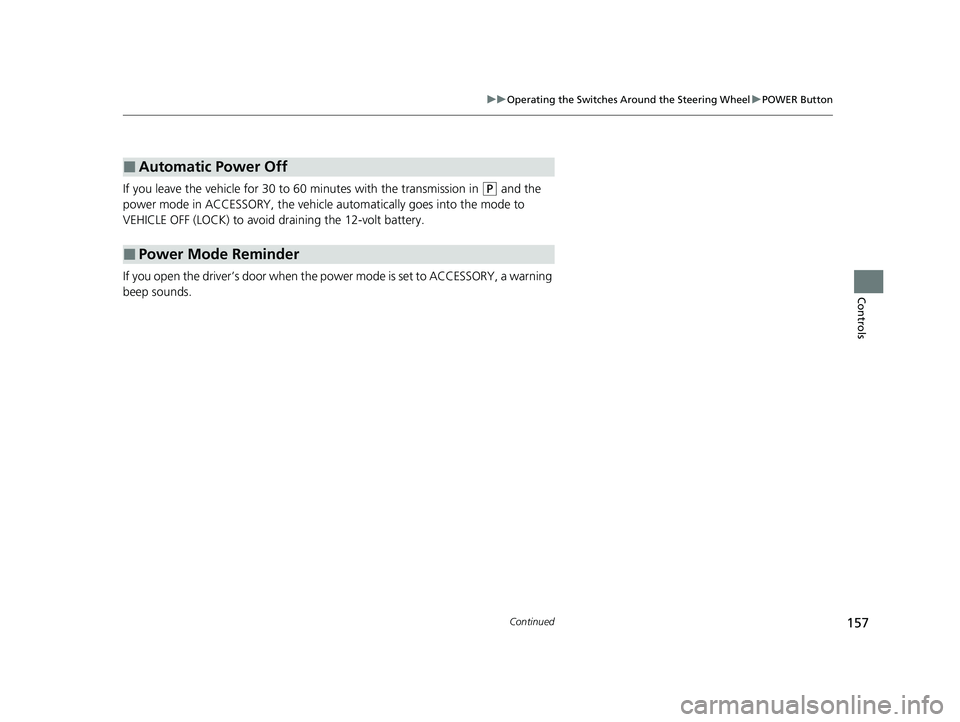
157
uuOperating the Switches Around the Steering Wheel uPOWER Button
Continued
Controls
If you leave the vehicle for 30 to 60 minutes with the transmission in (P and the
power mode in ACCESSORY, the vehicle au tomatically goes into the mode to
VEHICLE OFF (LOCK) to avoid draining the 12-volt battery.
If you open the driver’s door when the pow er mode is set to ACCESSORY, a warning
beep sounds.
■Automatic Power Off
■Power Mode Reminder
21 CLARITY FCV CSS-31TRT6400_02.book 157 ページ 2020年9月25日 金曜日 午 後3時15分